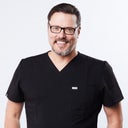Thank you for your question. You’re asking about the difference between PRP and ACell for hair restoration treatment.



